外研版Module3MusicReading教案
- 格式:docx
- 大小:17.88 KB
- 文档页数:7
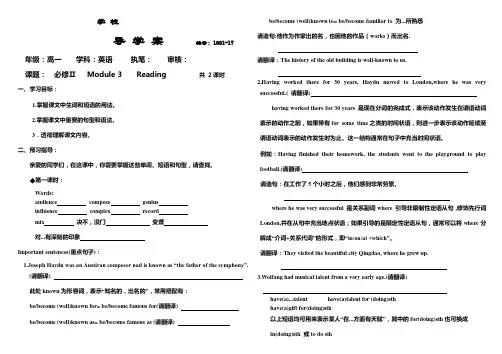
学校导学案编号:1001-17年级:高一学科:英语执笔:审核:课题:必修ⅡModule 3 Reading 共2课时一、学习目标:1.掌握课文中生词和短语的用法。
2.掌握课文中重要的句型和语法。
3.透彻理解课文内容。
二、预习指导:亲爱的同学们,在这课中,你需要掌握这些单词、短语和句型,请查找。
◆第一课时:Words:audience compose geniusinfluence complex recordmix决不,没门变聋对...有深刻的印象Important sentences(重点句子):1.Joseph Haydn was an Austiran composer nad is known as “the father of the symphony”.(请翻译)此处known为形容词,表示“知名的,出名的”,常用搭配有:be/become (well)known for= be/become famous for(请翻译)be/become (well)known as= be/become famous as (请翻译)be/become (well)known to= be/become familiar to 为...所熟悉请造句:他作为作家出的名,也因他的作品(works)而出名.请翻译:The history of the old building is well-known to us.2.Having worked there for 30 years, Haydn moved to London,where he was very successful.( 请翻译)having worked there for 30 years 是现在分词的完成式,表示该动作发生在谓语动词表示的动作之前,如果带有for some time之类的时间状语,则进一步表示该动作延续至谓语动词表示的动作发生时为止。
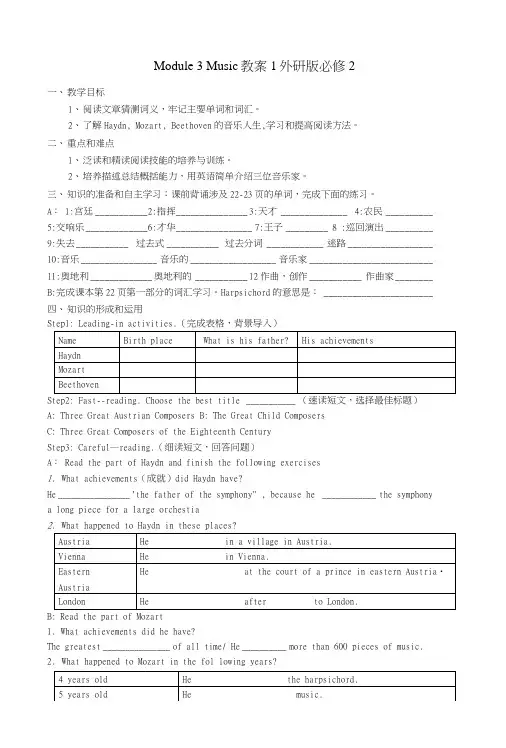
Module 3 Music教案1外研版必修2一、教学目标1、阅读文章猜测词义,牢记主要单词和词汇。
2、了解Haydn, Mozart, Beethoven的音乐人生,学习和提高阅读方法。
二、重点和难点1、泛读和精读阅读技能的培养与训练。
2、培养描述总结概括能力,用英语简单介绍三位咅乐家。
三、知识的准备和自主学习:课前背诵涉及22-23页的单词,完成下面的练习。
A: 1:宫廷___________ 2:指挥_______________ 3:天才 ______________ 4:农民__________ 5:交响乐_____________ 6:才华________________ 7:王子_________ 8 :巡回演出__________ 9:失去___________ 过去式___________ 过去分词 ____________ 迷路__________________ 10:音乐________________ 音乐的__________________ 音乐家__________________________ 11:奥地利_____________ 奥地利的___________ 12作曲,创作___________ 作曲家________ B:完成课本第22页第一部分的词汇学习。
Harpsichord的意思是: _______________________ 四、知识的形成和运用Stepl: Leading-in activities.(完成表格,背景导入)Step2: Fast--reading. Choose the best title ___________ (速读短文,选择最佳标题)A: Three Great Austrian Composers B: The Great Child ComposersC: Three Great Composers of the Eighteenth CenturyStep3: Careful―reading.(细读短文,回答问题)A: Read the part of Haydn and finish the following exercises1.What achievements(成就)did Haydn have?He ________________ 'the father of the symphony" , because he ____________ the symphonya long piece for a large orchestia2.What happened to Haydn in these places?B: Read the part of Mozart1.What achievements did he have?The greatest _______________ of all time/ He __________ more than 600 pieces of music. 2.What happened to Mozart in the fol lowing years?C: Read the part of Beethoven1. Try to translate the sentence into Chinese・However, it was Haydn who encouraged Beethoven to move to Vienna・2.What happened to him as he became old?As he grew older, he began to _________________ b ut he ________________________ e venwhen he became completely deaf・3.What achievements did he have?He ________________________ i n Austrian capitai and stayed there for _______________Step!: Post―reading.(回过头再来完善stepl的表格,整体了解3位咅乐家)Ste P5:合作探究.(以Mozart为例,分析篇章结构,总结如何描写名人)从下列各项中选出文中描写到的项,并把它们填入表格来完成文章的结构图表。
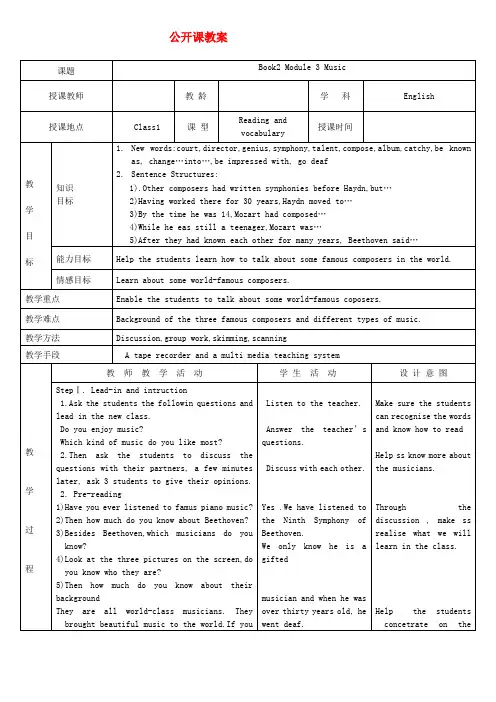
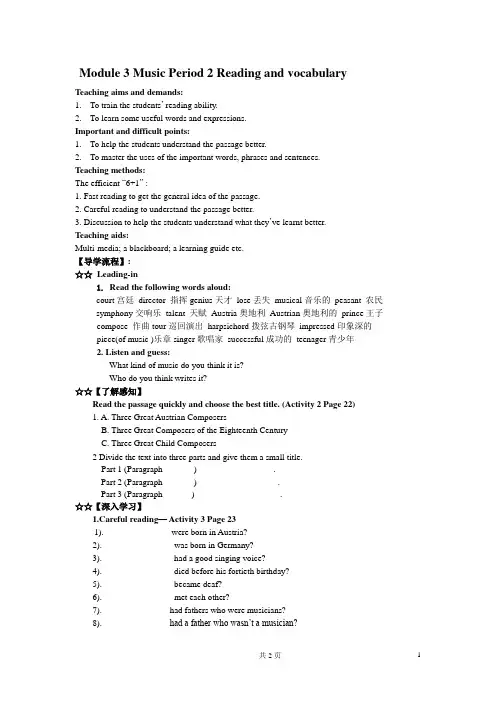
Module 3 Music Period 2 Reading and vocabularyTeaching aims and demands:1.To train the students’ reading ability.2.To learn some useful words and expressions.Important and difficult points:1.To help the students understand the passage better.2.To master the uses of the important words, phrases and sentences.Teaching methods:The efficient “6+1” :1. Fast reading to get the general idea of the passage.2. Careful reading to understand the passage better.3. Discussion to help the students understand what they’ve learnt better.Teaching aids:Multi-media; a blackboard; a learning guide etc.【导学流程】:☆☆Leading-in1. Read the following words aloud:court宫廷director 指挥genius天才lose丢失musical音乐的peasant 农民symphony交响乐talent 天赋Austria奥地利Austrian奥地利的prince王子compose 作曲tour巡回演出harpsichord拨弦古钢琴impressed印象深的piece(of music )乐章singer歌唱家successful成功的teenager青少年2. Listen and guess:What kind of music do you think it is?Who do you think writes it?☆☆【了解感知】Read the passage quickly and choose the best title. (Activity 2 Page 22)1. A. Three Great Austrian ComposersB. Three Great Composers of the Eighteenth CenturyC. Three Great Child Composers2 Divide the text into three parts and give them a small title.Part 1 (Paragraph ___-___) _________________.Part 2 (Paragraph ___-___) __________________.Part 3 (Paragraph___-___) ___________________.☆☆【深入学习】1.Careful reading— Activity 3 Page 231)._______________ were born in Austria?2).________________ was born in Germany?3). ________________had a good singing voice?4). ________________died before his fortieth birthday?5). ________________became deaf?6). ________________met each other?7). _______________had fathers who were musicians?8). _______________had a father who wasn’t a musician?2. Careful reading—filling in the three charts☆☆【迁移运用】Reading expression -Activity 4 on P231.How did Haydn change the form of symphonies? (within 10 words)_____________________2. How long did he work in eastern Austria? (within 2 words)_____________________________3. How many pieces of music did Mozart compose? (within 5 words)_______________________4. How old was he when he played for the Empress of Austria? (one word)___________________5. How long were Mozart and Haydn friends? (within 2 words)____________________________6. Who taught Beethoven how to play the piano? (within 2 words)__________________________7. What happened to him when he grew older? (within 6 words)___________________________。
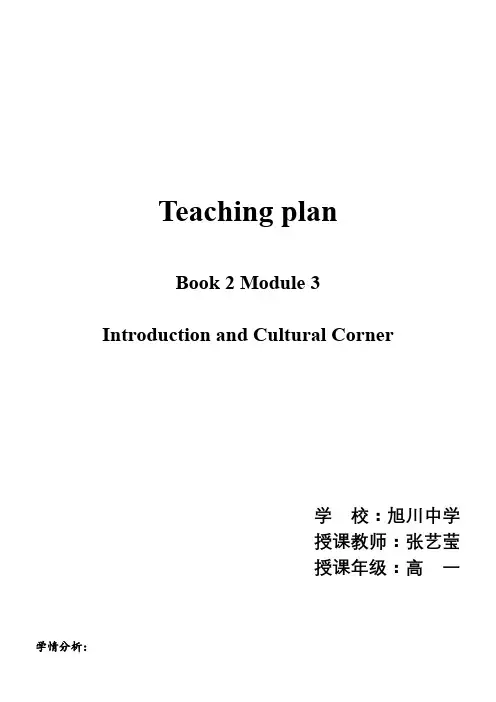
Teaching planBook 2 Module 3Introduction and Cultural Corner学校:旭川中学授课教师:***授课年级:高一学情分析:经过了较长时间的初高中英语课程衔接和适应,高一学生在单词记忆和阅读能力方面有了一定的提高。
但是学生对文本的理解还处于较为局限的范围,一篇文章读完后抓不住文章的重点内容以及要表达的情感价值观或者态度。
总之,学生读完后没有养成联系上下文思考问题以及概括文章核心内容的习惯。
英语课堂中如果有图片、音乐或者视频等教学资源的加入,学生们在该堂课上的学习兴趣会比平时高很多。
“音乐”这一话题也是学生所熟悉且热爱的日常生活的一部分,而且学生也了解一些有关音乐的词汇,因此单词的引入就较为容易。
Cultural corner部分的文章内容是有关音乐界著名人士的传记。
高中生对该类型的文章兴趣较为浓厚,但是如何把传记描述的内容有逻辑有条理的在脑海里清晰的呈现并形成完整的体系对学生们来说是一个难点。
因此,教学设计时的重点就要引导学生剖析文章,联系上下文,对文章有一个全局的把握。
教学内容分析:本堂课的教学内容是外研社高中英语必修二第三模块里的Introduction和Cultural Corner两个部分。
本模块的话题是“Music”。
通过对本模块的学习,学生可以了解古今中外的音乐家及其事迹,丰富音乐知识,提高学生的音乐素养。
Introduction部分主要通过活动来让学生复习和学习一些与话题music有关的词汇,比如乐器、音乐家和音乐流派等相关词汇。
学习单词的同时激发学生的学习兴趣。
Cultural corner部分学习一篇有关于作曲家叶小刚的人物传记。
该篇人物传记以时间线为线索介绍了叶小刚的生平经历与成就。
通过学习了解他的音乐生涯、经历和成就,同时还能够增强学生的民族自豪感。
Teaching Aims:1.Knowledge1). To learn some words about music2). To understand the elements and structure of biography.2.Ability1). To try to express the likes and dislikes about music.2).To master the reading skills of skimming and scanning3). To understand how to write a piece of writing about a person’s life.4). To improve the abilities of listening, speaking, reading and writing.3.Emotion and ValuesTo strengthen the national sense of pride.Important points:1)To master the words related to music.2)To learn to analyze and master biographical articles.Difficult point:1)To read with strategies of skimming and scanning.2)To analyze the text with a mind map.3)To learn to write a biography.Teaching steps:Step1 Lead-inStep 2 Introduction1. Share some pictures about the comments of music and an interview video to inspire students’ interest.2. Activity---competitionStep 3 Cultural Corner---Ye Xiaogang1. Pre-reading2. While-reading1). Skimming: choice question2). Scanning: draw a mind map3. Post reading1). work with students to conclude the structure of the biography.2). Make a summary about “how to describe a famous person” (how to write a biography).Step 4 HomeworkTeaching procedures:Step1. Lead-inListen to a song to relax the students and lead in the topic about music.Step 2. Introduction1. Share some pictures about the comments of music and an interview video to inspire students’ interest.2. Activity---competitionThe teacher will give students three topics about music and ask the whole class to think about words related to these topics. About the first topic, the teacher will divide the whole class into two groups to make a competition. Meanwhile, the teacher will find out two students from both groups to come to the blackboard to write down words that their group members mention. The winning group will receive a prize.Brainstorming: 1. Types of music2. musical instruments3. people related to musicStep 3. Cultural Corner---Reading1. Pre-readingA brief introduction to Ye Xiaogang to stimulate students’ interest.2. While-reading1). skimmingListen to the tape and read the passage quickly, and then choose the type of writing about the passage Ye Xiaogang.2). scanninga. Read the passage carefully and find out the numbers in this passage.1955:4 years old:1978-1983:1985:1986:1996:since 1993:b. Ask students to draw a mind map(思维导图)about the experiences and achievements of Ye Xiaogang according to these numbers. Then the teachers will share some productions with the whole class.3. Post reading1). Give students a brief introduction about Ye Xiaogang according to the original text and work with students to conclude the structure of the biography.“Ye Xiaogang, who was born in 1955, is one of a group of Chinese composers known as the New Tide. From 1978 till 1983, He studied at the Central Conservatory of Music of China. In 1985, there was a concert of Ye Xiaogang's symphonies in Beijing. In 1986, his album Horizon appeared and he is famous for mixing Chinese musical traditions with western forms and instrumentation. Besides, he is a members of Eclipse, perhaps the first independent music group in China which plays works by modern Chinese composers. Since 1993, he has worked part of the time in Beijing and in the US.”a.“who was born in 1955” --- his date of birthb.“…is one of a group of Chinese composers known as the New Tide.” --- his social statusc.“From 1978 till 1983, He studied at…Since 1993, he has worked part of the time in Beijing and inthe US.” --- his experience and achievement.2). Make a summary about “how to describe a famous person” (how to write a biography).a.Date and place of birthb.Statusc.Experienced.achievementse.Family backgroundStepWriting: describe Lang Lang from at least three aspects.板书设计:教学反思:对于高中阶段的学生,尤其是理科生而言,英语是一门较为枯燥的学科。
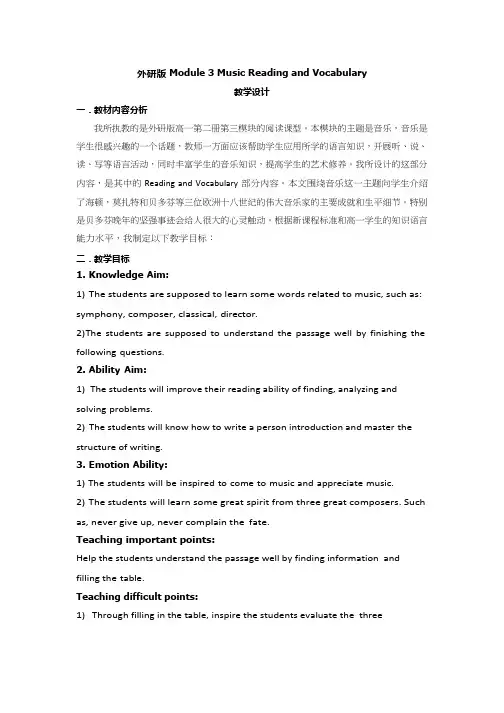
外研版Module 3 Music Reading and Vocabulary教学设计一.教材内容分析我所执教的是外研版高一第二册第三模块的阅读课型。
本模块的主题是音乐,音乐是学生很感兴趣的一个话题,教师一方面应该帮助学生应用所学的语言知识,开展听、说、读、写等语言活动,同时丰富学生的音乐知识,提高学生的艺术修养。
我所设计的这部分内容,是其中的Reading and Vocabulary 部分内容。
本文围绕音乐这一主题向学生介绍了海顿,莫扎特和贝多芬等三位欧洲十八世纪的伟大音乐家的主要成就和生平细节。
特别是贝多芬晚年的坚强事迹会给人很大的心灵触动。
根据新课程标准和高一学生的知识语言能力水平,我制定以下教学目标:二.教学目标1.Knowledge Aim:1)The students are supposed to learn some words related to music, such as: symphony, composer, classical, director.2)T he students are supposed to understand the passage well by finishing the following questions.2.Ability Aim:1)The students will improve their reading ability of finding, analyzing and solving problems.2)The students will know how to write a person introduction and master the structure of writing.3.Emotion Ability:1)The students will be inspired to come to music and appreciate music.2)The students will learn some great spirit from three great composers. Such as, never give up, never complain the fate.Teaching important points:Help the students understand the passage well by finding information and filling the table.Teaching difficult points:1)Through filling in the table, inspire the students evaluate the threecomposers and express what they have learned.2)The students master the structure of writing a person.教学过程设计Step 1. GreetingsStep 2. Lead-in (watch the video)活动:Act out the given situations and answer the question.The teacher broadcast the video.Give the following questions according to the song.1)Do you like the song ?2)Do you know who wrote this song? (引出其中的一个主人公莫扎特)1)老师播放音乐会视频营造轻松的课堂氛围,调动学生的积极性。
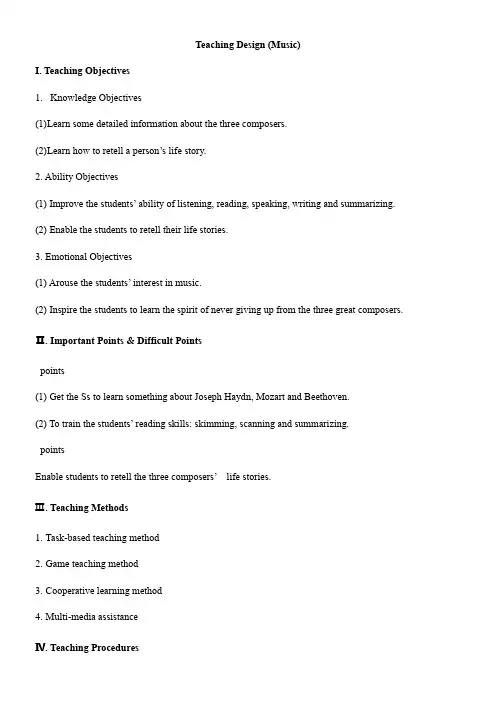
Teaching Design (Music)I. Teaching Objectives1.Knowledge Objectives(1)Learn some detailed information about the three composers.(2)Learn how to retell a person’s life story.2. Ability Objectives(1) Improve the students’ ability of listening, reading, speaking, writing and summarizing.(2) Enable the students to retell their life stories.3. Emotional Objectives(1)Arouse the students’ interest in music.(2) Inspire the students to learn the spirit of never giving up from the three great composers.Ⅱ. Important Points & Difficult Pointspoints(1) Get the Ss to learn something about Joseph Haydn, Mozart and Beethoven.(2) To train the students’ reading skills: skimming, scanning and summarizing.pointsEnable students to retell the three composers’ life stories.Ⅲ. Teaching Methods1.Task-based teaching method2.Game teaching method3.Cooperative learning method4.Multi-media assistanceⅣ. Teaching ProceduresStep I Lead-in (3mins)Show a video and ask students a series of questions:who is she, what is she doing,who composed this piece of music?Step II Fast-reading (5mins)Task1: SkimmingAsk students to divide the passage into three parts.Task2: ScanningAsk students to scan the passage and get some key information from the following three aspects:birthplace, his father, title.Step III Detailed-reading(18mins)Task1 Ask students to read part 1 and complete the sentences.What happened to him in these places?____________in Austria.________________ in Vienna._____________________________in Eastern Austria.____________________ in London.Task2 Read part 2 and find out some numbers and the related information.Task3 Read part 3 and draw a mind-map to show the relationship among the three composers.Task4 A guessing gameShow some information about the composers, and ask students to guess whom it refers to.Step IV Post-reading (13mins)Task1 Make a summaryLead students to sum up what the three composers have in common to be successful.Task 2 RetellingAsk students to choose one of the three composers, and then retell his life story according some key information in the table.Step V Homework (1mins)Write a composition about your favorite musicians or actors.Ⅴ. Blackboard DesignⅥ. Teaching Effective and ReflectionThrough the learning of this lesson, students are supposed to1.Have a good understanding of the framework of the passage.2.Know more about the three composers.3.Be able to retell the life story of each composer.4.Be able to respect the great persons and learn from them.。
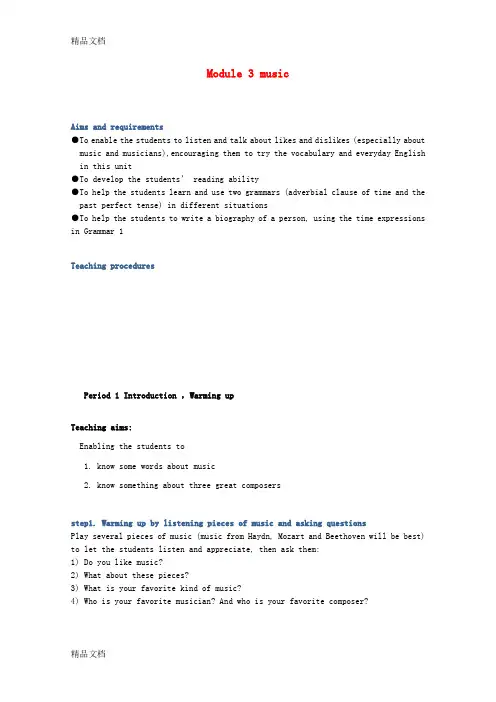
Module 3 musicAims and requirements●To enable the students to listen and talk about likes and dislikes (especially aboutmusic and musicians),encouraging them to try the vocabulary and everyday English in this unit●To develop the students’ reading ability●To help the students learn and use two grammars (adverbial clause of time and thepast perfect tense) in different situations●To help the students to write a biography of a person, using the time expressions in Grammar 1Teaching proceduresPeriod 1 Introduction ,Warming upTeaching aims:Enabling the students to1. know some words about music2. know something about three great composersstep1. Warming up by listening pieces of music and asking questionsPlay several pieces of music (music from Haydn, Mozart and Beethoven will be best) to let the students listen and appreciate, then ask them:1) Do you like music?2) What about these pieces?3) What is your favorite kind of music?4) Who is your favorite musician? And who is your favorite composer?step2. Warming up by showing some pictures and discussing1) Do you know who they are?2) What kind of things are these pictures connected with, science, culture, politics, painting, drawing or music?step3. Warming up by listening to a piece of musicGood morning, class. Today we are going to read a passage about three great musicians who are all composers. A composer is a musician who writes pieces of beautiful music for others to sing or to play. Now,let’s listen to a piece of music.(the teacher plays a piece of music ----er quan yingyue)1.do you know what kind of music it is?2.whose work is it?3.what kind of music is it?4.what is your feeling after listening to it?Step 4 show the following picturesAnd make the students familiar with these new words:Piano violin saxphone drum erhu guitarste p4.now please match these musical instruments with their names.Step 5 work in groups to discuss these questions:1.which of the instruments do you like listening to?2.which famous musicians play them?3.is the chinese instruments different from the other instruments?describe thedifference,if there is one.Step6 summary and homework:Today we’ve learnt the Introduction,know something about music,and we’ve also learnt some new words.The homework:1.Try to instruct your favorite musician to your class orally.2.Learn the new words again, using the dictionary if necessaryPeriods 2 Reading and VocabularyTeaching Aims:Train the students' reading ability.Learn some useful words and expressions.Teaching Important Points.Help the students to understand the passage better.Learn and master some important words and phrases in this period.Teaching Difficult Points:How to help the students improve their reading and understand the passage better. Teaching Methods:Fast reading to get the general idea of the text.Careful reading to understand the passage better.Discussion to help the students understand what they've learned better.Teaching procedure.Step 1 Lead --inThe teacher may play a kind of music written by Beethoven.------- What kind of music do you think it?----- Who do you know wrote it ?The teacher may discuss the questions and answer them freely.T: As we know, there are various kinds of music around the world. They all have their own obvious characteristic. And also there were famous composers such as Joseph Haydn, Mozart, and Beethoven. Today we may learn of their life from the text.Step 2 Reading comprehension.Fast reading: Read the passage quickly and choose the best title.A.Three Great Austrian Composers.B.Three Great Composer of the eighteenth Century.C.Three Great Child Composers.Key: B.Now let's read the passage again, underline new words in the text and decide whether the following statements are right or not.1.The three composers were all born in Austria.2.Mozart had a beautiful singing voice.3.Mozart died before his fortieth birthday.4.Beethoven once worked at the court of a prince, who began to go deaf when he grew older.5.Beethoven had ever met Haydn, but he didn't think he taught him a lot.6.Both Haydn and Mozart had fathers who were musicians.Key:1.F Beethoven was born in Bonn, Germany.2.F. Haydn had a good singing voice.3.T4.F. Haydn once worked at the court of a prince, but he didn't go deaf.5.T6.F. Haydn was the son of a peasant( The teacher may begin with the T/F questions orally and this is a good time to test their listening abilities as well as their comprehension of the text. )Step 3 Read and listen to the passage. Meanwhile, some more questions are waiting for you.1.How did Haydn change the form of symphonies?2.How long did he work in eastern Austria?3.How many pieces of music did Mozart compose?4.How old was he when he played for the Empress of Austria?5.How long were Mozart and Haydn friends?6.Who taught Beethoven how to play the piano?7.Did he stop composing when he became deaf?Keys:1 He changed the symphony into a long piece for a large orchestra.2. 30 years.3.More than 600 pieces of music.4. When he was 6 , he played the harpsichord in a concert for the Empress of Austria.Periods 3, Function and GrammarTeaching aims:1 To learn grammar rules2 To use the grammar rules for correct communication3 To study co-operatelyTeaching important points: To use the correct tense and the proper conj. Teaching difficult points: To use correctly the two tenses and the three conj. Teaching methods: Explanation and practiceTeaching procedure:Step Ⅰ Lead-in by telling the class what happened to the Shenzhou Ⅻand technology is developing rapidly, China has achieved a lotin the area of.Shenzhou Ⅻthe whole nation were waiting and back home from schooland heard the news, I couldn’t help getting exciteed. I feel proud ofour country.Step Ⅱ Grammar 11 Make sentences with “when , while, come in , have a lesson”( Here is a picture of a classroom and a student coming in)A When he came in, we were having a lesson.B When we were having a lesson, he came in.C While we were having a lesson, he came in.2 Say the meaning of “as” in the following sentences.D As he was a child, he studied drawing.E As he grew older, he began to go deaf.F He listened to music as he walked.当…之时随着一边…一边…3Answer the three questions.When we talk about a single event in the past,we use when as in A .When we talk about a period of time in the past,we use when/ while / asas in B C D.We use as to refer to a progressive change as in E F .4PracticeComplete the following sentences with “when ,while , as”(1) ___she was studying at school, she also sang in the school choir.(2) ___he was living in Vienna, he studied music.(3) ___she met bach,she was only 20 years old.(4) ___he grew older, he found it more difficult to compose music(5) ___he was playing in the orchestra, he met his wife.(6) ___he was working in Hollywood, he became ill and died.(7) ___I listened to the violin solo, I fell in love with classical music.(8) ___they toured Europe for 10 years, they finnally decided to live inAustrilia.Step Ⅲ Grammar 2 The past perfect tense1Read the following sentences and summarise rules, paying attention to tenses.Fill in the blanks.After Liping had finished doing his homework, he turned on the TV.After they had got everything ready, they began to do the experiment.Before he came to our school, he had taught English for several years.Before his letter reached me, I had received his telephone call.They had finished the project by last month.I had left the country by the time the letter reached me.had done before diddid after had donehad done by did/past time2 PracticeWorkbook Grammar (2)(3)(4)Complete the sentences using the verbs in brackets and the past simple or past perfect tense.Step Ⅳ1 Game Oral practice ,pair work.Ask and answer questions using all kinds of tenses.Example:-- When did you have your breakfast this morning?-- At 6.-- Have you prepared for the English lesson?-- Yes, I have. I have finished the exercises in the workbook.2 Watch a vedio play.Step Ⅴ Sum upAsk some students to make sentences using “when, while, as, before, after, by”. Step Ⅵ Homework: Present a biography of a famous Chinese musician or composer.Periods 4 Speaking and WritingTeaching Aims:1.Knowledge and Skilla.To develop speaking ability by talking about likes and dislikes.b.To learn about some vocabulary and knowledge related to music and composers.c.To develop writing ability by presenting a biography of a famous Chinesemusician or composer.d.Train the ability of collecting and dealing with information, and develop theirabilities of getting new information, communication and cooperation.2.Emotion and Valuesa.To raise students’ interests in science and form the right attitude towardsall kinds of music.b.To help them know Chinese traditional music well and cultivate their interestin playing some Chinese instrument.3. Character-building:a.To make them know how to enjoy different kinds of music.b.Arouse their interest of playing some kinds of instrument and enrich theirleisure time.4. Cross-cultural awarenessa.To help them know the difference between China and some western countries ininstruments.b.Cultivate their awareness of cultural communication through the speciallanguage—music.Difficulties and Importance:a.To make the students understand and grasp the vocabulary and knowledge relatedto music.b.To enable the students to know how to use adverbial clause of time. Teaching Method:a.Task-based methodologymunicative ApproachTeaching Procedures:Step 1 Pre-readingLook at the picture and answer the following questions.1.Who is he?2.Have you ever know something about him?Step 2 While-readinga. SkimmingRead the passage quickly, and make a note of some basic information about Ye xiaogang.Suggested answers:b. Detailed readingRead the passage carefully and fill in the blanks with proper words. Find what Ye Xiaogang did or what happened to him in the following years:Suggested answers:Step 3. Post-readingDiscussion.1.Are there any similarities between Ye Xiaogang and the European composers you haveread about in this module?2.Do you think it is a good idea to mix Chinese and western music?Step 4 Everyday Englisha. Listen to two people talking about the way they listen to music and answer the questions.1.How do they listen to it?2.Are they happy with the way they listen to music?3.What does Anna offer to do for Tom?b. work in pairs. Discuss your favourite music and how you listen to it.Step 4 Guided writingWrite a short passage of a famous singer in China—Han Hong.The following words may help you:1. sing well successful song writer2.born in1971 in Tibet(西藏)3. young watch her mother sing and dance4. at the age of nine professional(专业的) training in Beijing.5. in 1985 her first national prize6. write songs in 19937. song Hometown number one in ChinaHomework:1.2.Finish writing the biography of Han Hong—a famous Chinese singer.3.Finish other exercises in this module.Periods 5 culture cornerTeaching aims:Enabling the students to1. to know sth about Ye Xiaogang2. write a biography of a famous Chinese musician or composer.Teaching steps:I. Ask some students to say something about Mozart.Give as many details as possible. II. Try to think of a Chinese musician or composer, eg. Xu Peidong.Gather these materials.1. when, where and in what kind of family he/ she was born.2. how he/ she spent his/ her childhood or youth.3. about his/ her education4. what are his/ her famous works5. what his/ her style is / wasGroup work. Ask the students to discuss about the musician or composer.Then ask some students to stand up to say sth. about the musician or composer.Correct the mistakes if any.III. Cultural Corner.Ye Xiaogang1. Listen to the passage and try to find the answer to this question:When did his album Horizon appear? (in 1986)2. Read the passage thoroughly and make a note of the information about Ye Xiaogang.Name:_________________ Sex: __________________Nationality:_____________ Job:___________________Main achievements: ____________________________________________Style of music: ____________________________What he did or happened to him in the following years:1955: ___________________________________________From 1978 to 1983: ___________________________________________1985: ___________________________________________1986: ___________________________________________1996: ___________________________________________3. Check the answers with the whole class. Then ask one or two students to say sth about Ye Xiaogang with the help of the notes made.4. Language points:1) work as2) leading modern composers 主要作曲家leading article 社论the leading cause 主要原因a leading role 主角3) mix A with B= mix A and B togethermix win with waterNever mix with such people.mix up 弄混,弄错It’s common to mix him up with his brother.弄乱mix up the papersmix up those data4) receive many prizes5) part ofIV. Homework:Write a short passage about the Chinese musician or composer we talked about this period.。
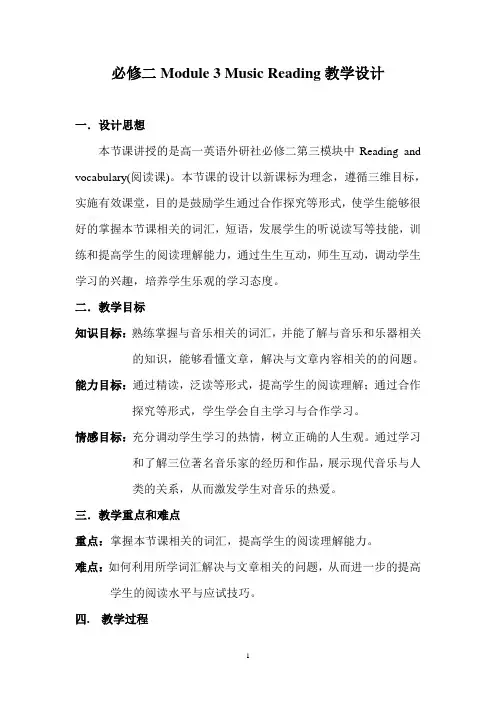
必修二Module 3 Music Reading教学设计一.设计思想本节课讲授的是高一英语外研社必修二第三模块中Reading and vocabulary(阅读课)。
本节课的设计以新课标为理念,遵循三维目标,实施有效课堂,目的是鼓励学生通过合作探究等形式,使学生能够很好的掌握本节课相关的词汇,短语,发展学生的听说读写等技能,训练和提高学生的阅读理解能力,通过生生互动,师生互动,调动学生学习的兴趣,培养学生乐观的学习态度。
二.教学目标知识目标:熟练掌握与音乐相关的词汇,并能了解与音乐和乐器相关的知识,能够看懂文章,解决与文章内容相关的的问题。
能力目标:通过精读,泛读等形式,提高学生的阅读理解;通过合作探究等形式,学生学会自主学习与合作学习。
情感目标:充分调动学生学习的热情,树立正确的人生观。
通过学习和了解三位著名音乐家的经历和作品,展示现代音乐与人类的关系,从而激发学生对音乐的热爱。
三.教学重点和难点重点:掌握本节课相关的词汇,提高学生的阅读理解能力。
难点:如何利用所学词汇解决与文章相关的问题,从而进一步的提高学生的阅读水平与应试技巧。
四. 教学过程Step 1 Revision复习:复习上一节课所学的单词。
因为在进入本单元课文之前,我已经把要点单词教授完毕。
所以,在复习的环节中,我让学生进行英语单词竞赛,让同学看着大屏,给出单词,在此过程中,要注意自己发音的准确和语流语调。
Try to guess words:1 A group of people who sing together form a _____.2 We call a large group of musicians who play together on variousinstruments an _________.3 One who directs an orchestra or other such group is a _________.4 An organized company of singers is a _____.5 People who compose music are called___________.Step 2 Lead-in导入:一节课的成败,导入环节起着一个至关重要的作用。
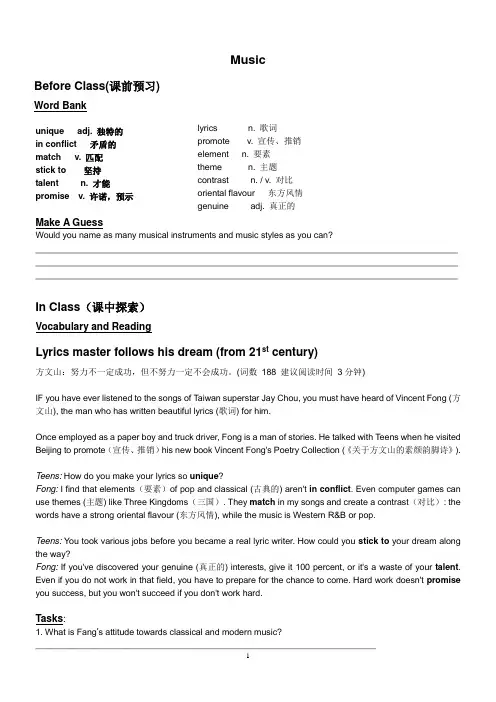
MusicBefore Class(课前预习) Word Bankunique adj. 独特的in conflict 矛盾的match v. 匹配stick to 坚持talent n. 才能promise v. 许诺,预示Make A GuessWould you name as many musical instruments and music styles as you can?____________________________________________________________________________________________________________________________________________________________________________________________________________________________________In Class (课中探索) Vocabulary and ReadingLyrics master follows his dream (from 21st century)方文山:努力不一定成功,但不努力一定不会成功。
(词数 188 建议阅读时间 3分钟)IF you have ever listened to the songs of Taiwan superstar Jay Chou, you must have heard of Vincent Fong (方文山), the man who has written beautiful lyrics (歌词) for him.Once employed as a paper boy and truck driver, Fong is a man of stories. He talked with Teens when he visited Beijing to promote (宣传、推销)his new book Vincent Fong's Poetry Collection (《关于方文山的素颜韵脚诗》).Teens: How do you make your lyrics so unique ?Fong: I find that elements (要素)of pop and classical (古典的) aren't in conflict . Even computer games can use themes (主题) like Three Kingdoms (三国). They match in my songs and create a contrast (对比): the words have a strong oriental flavour (东方风情), while the music is Western R&B or pop.Teens: You took various jobs before you became a real lyric writer. How could you stick to your dream along the way?Fong: If you've discovered your genuine (真正的) interests, give it 100 percent, or it's a waste of your talent . Even if you do not work in that field, you have to prepare for the chance to come. Hard work doesn't promise you success, but you won't succeed if you don't work hard.Tasks :1. What is Fang ’s attitude towards classical and modern music?______________________________________________________________________lyrics n. 歌词 promote v. 宣传、推销 element n. 要素 theme n. 主题 contrast n. / v. 对比 oriental flavour 东方风情 genuine adj. 真正的2. Word study:make use of the following words to complete the sentences.1)Mozart had musical __________ from a very early age.2)My tie and my suit don’t ______________.3)Vincent Fang’s ___________ style is loved by many, as it is different from anyone else’s.4)My father __________ me a New Year gift, but he forgot all about it.5)You must _________ _____ your dream and finally you will succeed.6)The two countries were ____ _________, but there wouldn’t be a war because we all wanted peace.After Class (课后巩固)Assignment:Write a short paragraph expressing your own attitude and opinion on classical and modern music._______________________________________________________________________________________ _______________________________________________________________________________________ _______________________________________________________________________________________ _______________________________________________________________________________________ _______________________________________________________________________________________ _______________________________________________________________________________________。
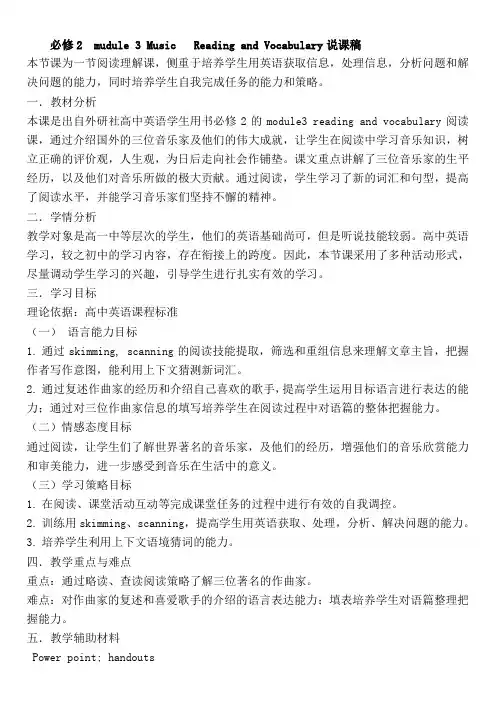
必修2 mudule 3 Music Reading and Vocabulary说课稿本节课为一节阅读理解课,侧重于培养学生用英语获取信息,处理信息,分析问题和解决问题的能力,同时培养学生自我完成任务的能力和策略。
一.教材分析本课是出自外研社高中英语学生用书必修2的module3 reading and vocabulary阅读课,通过介绍国外的三位音乐家及他们的伟大成就,让学生在阅读中学习音乐知识,树立正确的评价观,人生观,为日后走向社会作铺垫。
课文重点讲解了三位音乐家的生平经历,以及他们对音乐所做的极大贡献。
通过阅读,学生学习了新的词汇和句型,提高了阅读水平,并能学习音乐家们坚持不懈的精神。
二.学情分析教学对象是高一中等层次的学生,他们的英语基础尚可,但是听说技能较弱。
高中英语学习,较之初中的学习内容,存在衔接上的跨度。
因此,本节课采用了多种活动形式,尽量调动学生学习的兴趣,引导学生进行扎实有效的学习。
三.学习目标理论依据:高中英语课程标准(一)语言能力目标1.通过skimming, scanning的阅读技能提取,筛选和重组信息来理解文章主旨,把握作者写作意图,能利用上下文猜测新词汇。
2.通过复述作曲家的经历和介绍自己喜欢的歌手,提高学生运用目标语言进行表达的能力;通过对三位作曲家信息的填写培养学生在阅读过程中对语篇的整体把握能力。
(二)情感态度目标通过阅读,让学生们了解世界著名的音乐家,及他们的经历,增强他们的音乐欣赏能力和审美能力,进一步感受到音乐在生活中的意义。
(三)学习策略目标1.在阅读、课堂活动互动等完成课堂任务的过程中进行有效的自我调控。
2.训练用skimming、scanning,提高学生用英语获取、处理,分析、解决问题的能力。
3.培养学生利用上下文语境猜词的能力。
四.教学重点与难点重点:通过略读、查读阅读策略了解三位著名的作曲家。
难点:对作曲家的复述和喜爱歌手的介绍的语言表达能力;填表培养学生对语篇整理把握能力。
Module 3 MusicSection Ⅰ Introduction & ReadingPre-readingFolk songs are the songs that are made up by common people. Many folk songs tell about heroes, robbers or young girls. Others, like OldMacDonaldHadaFarm, are just for fun. Some folk songs are about the kinds of work that people do. Christmas carols (圣诞颂歌) are folk songs, and so are the patriotic (爱国的)songs of many countries.Every country has its own folk songs. Most of these songs were made up long ago, and people have been singing them for hundreds of years.Of course, in China, we also have a long and honoured tradition of folk songs and folk singers. Like all folk songs, they come from the ordinary people and tell of things in ordinary lives. There are three main kinds of Chinese folk songs: Hao Zi, Xiao Diao and Shan Ge.Hao Zi is sung by males. Shan Ge is sung by two people,while Xiao Diao, with its beautiful tone, is usually sung by girls.And in this module we’ll learn something interesting and important about some foreign musicians. We’ll be impressed by their special experiences and talent in music. Well, let’s begin.Section_ⅠIntroduction & Reading —Prereading[原文呈现][读文清障]Joseph Haydn(1732-1809)was an Austrian composer①and is known as②“the father of the symphony③”. Other composer s had written symphonies before Haydn, but he changed the symphony into④ a long piece for a large orchestra⑤.He was born in a village in Austria⑥, the son of a peasant⑦. He had a beautiful singing voice⑧. After studying music in Vienna⑨,Haydn went to work at the court○10 of a prince ⑪in eastern Austria, where he became director⑫ of music. Having worked there for 30 years⑬, Haydn moved to London, where he was very successful.Wolfgang Amadeus Mozart (1756-1791) was a composer, possibly the greatest musical genius⑭ of all time⑮. He only lived 35 years and he composed⑯more than 600 pieces of music.Mozart was born in Salzburg, Austria. His father Leopold was a musician⑰ and orchestra conductor⑱. Wolfgang had musical⑲talent⑳from a very early age. He learned to play the harpsichord○21 when he was four, he started composing music when he was five, and when he was six, he played the harpsichord in a concert for the Empress○22 of Austria.By the time he was 14, Mozart had①composer/kəm’pəʊzə/n.作曲家②be known as作为……而著名③symphony/’sImfəni/n.交响乐;交响曲;交响乐团④change ...into ...把……转变成……⑤orchestra/’ɔːkIstrə/n.管弦乐队(团)⑥Austria/’ɒstriə/n.奥地利⑦peasant/’peznt/n.农民the son of a peasant是he的同位语。
外研版必修二Module3 Music教学设计案例教学设计理念《普通高中英语课程标准》指出,高中阶段的英语教学应注重培养学生的自主学习和合作学习的能力,帮助学生形成有效地学习策略,培养学生用英语获取信息、处理信息、分析问题和解决问题的能力;教师要鼓励学生通过积极尝试、自我探究、自我发现和主动探究等学习方式形成适合自己的学习方法。
基于以上要求,本节课教学主要采用“任务型教学”途径和“互动式”教学模式,以学生为主体,以任务为主线,突出交际性,重视体验参与,借以提高学生的扫读、查读、精读等阅读微技能。
一、教材分析本节课是高中英语必修二第三模块阅读部分。
本模块的主题是音乐,课文围绕音乐这一主题向学生介绍了海顿、莫扎特和贝多芬三位欧洲十八世纪伟大的音乐家的主要成就和生平细节。
但由于文章篇幅较长,信息量较大,所以本人结合学生的现有认知水平,将阅读教学按照内容分成三大部分,并通过设计不同的教学活动,让学生依次掌握有关海顿、莫扎特和贝多芬的知识,帮助学生加深对三位音乐家的理解;同时借助欣赏三位音乐家的音乐作品,丰富学生的音乐知识,提高他们的艺术修养。
二、学情分析现阶段学生已基本适应了高中的学习生活,完成了初高中英语的衔接;具备了一定的语言基础,能够就某一话题发表自己的观点和看法;喜爱音乐并对这三位音乐家有不同程度的了解。
以上因素都有助于降低学生学习新知识的畏惧感,激起学生学习本课的兴趣和欲望,课堂上也会更积极主动地参与各种教学活动,为本节课的顺利进行奠定了基础。
三、教学目标知识与技能1.学完本课后,学生能够掌握一些与音乐有关的词汇和句型,并能介绍三位音乐家的生平及成就。
2.通过完成一系列练习,学生可以提高扫读、查读、精读等阅读微技能。
过程与方法通过独立学习及小组合作竞赛的方式提高学生的自主学习和合作学习能力,激发学生学习英语的兴趣,提高课堂教学效率。
情感态度与价值观引导学生热爱音乐,丰富有关古典音乐的知识,提高音乐鉴赏力。
Module 3 Music reading学案学习目标:1. Learn something about word-famous composers2. Learn the following important and difficult phrases and sentences in the passage. Phrases: be known as, change… into, a beautiful singing voice, of all time, from a very early age, be impressed with, for the rest of his life, go deaf Sentences:●Having worked there for 30 years, Haydn moved to London, where he was verysuccessful.●By the time he was 14, Mozart had composed many pieces for the harpsichord,piano and violin, as well as for orchestras.●While he was still a teenager, Mozart was already a big star and toured Europegiving concerts.●It was Haydn who encouraged Beethoven to move to Vienna.●As he grew older, he began to go deaf.3. Develop your love for music.学习过程与方法:Task 1: Enjoy a piece of music by Beethoven on PPT.Task 2: Review the words in the box on P22.Task 3: Skimming: Read the passage quickly and choose the best title in Ex 2 on P22. Task 4: Careful reading : Read the passage carefully and fill in the form.About HaydnAbout MozartAbout BeethovenTask 5: Read the passage again and underline important phrases and sentences. And make a mark(作标记) where you can’t understand.Task 6: Share your phrases, sentences and your questions in groups.Task 7:Share your understanding of these phrases and sentences with the whole class.Task 8: Follow your teachers to get a better understanding of the important phrases and sentences on PPT.Task 10: Prediction: read the title of the passage and try to guess what will be talked about.Task11: Scanning: read the passage quickly and summarize the main idea of thepassage.Task12: Careful reading: Read the passage carefully and answer the followingquestions.1.Which composers group does Ye Xiaogang belong to? ( within 5 words)2.When did he begin to study piano? (within 10 words)3.What did he work as after he graduated from the central conservatory ofmusic? (within 5 words)4.What is Ye Xiaogang famous for? (within 15 words)5.Translate the sentence into Chinese.From that time, he has been one of the leading modern composers ofChinese classical music.Task 13: Read the following sentences and try to translate them into Chinese. While:1.Our house must have been broken into while we were asleep.2.While I am poor, I still feel happy every day.3.Tom is very good at Science, while his brother is absolutely hopeless.When:1.I loved history when I was at school.2.I was about to go out when my friend came to visit me.As:1.As she grew older she gained in confidence.2.“ No, I won’t, I’ll be fine, ” said Zhou kai, as he opened the door.巩固练习1.Finish Ex1, Ex2, on p.792.Translation(1)他在看书时,他的妻子一直在烧饭。
A Lesson Plan for the Reading and V ocabulary in Unit 3 Book 2执教学生:HouHouTopic: MusicContents:1.The new words and expression in this passage2.The adverbial clause of time3.Three famous foreign composer and some instrumentsTeaching aims:1.Knowledge aims(1) Students are able to use these important words: composer; symphony;orchestra; peasant; court; director; musical; genius; piece(of music);conductor; harpsichord; teenager;(2) Students are able to use these important phrase: change...into...; as well as;be impressed with; the rest of;(3) Students are able to understand these important sentences:1)After studying music in Vienna, Haydn went to work at the court of a prince in eastern Austria, where he became director of music.2) He learned to play the harpsichord when he was four, he started composingmusic when he was five, and when he was six, he played the harpsichord in aconcert for the Empress of Austria3)He showed musical talent when he was very young, and learned to play the violin and piano from his father, who was a singer.4)However, it was Haydn who encouraged Beethoven to move to Vienna.2.Ability aims(1) Listening: Students are able to understand teacher’s requests.(2) Speaking: Students are able to organize their language and talk about someworld-famous composers;(3) Reading: Students are able to understand the main idea of this passage(4) Writing: Students are able to extract the key words and write them correctly. 3.Emotional aims(1) Students are able to develope interests on music(2) Students are able to understand no matter what kind of trouble they drop in,they should still be positive and never give up.4.Culture awareness(1) Students are able to know some famous foreign composers(2) Students are able to know some instrumentsTeaching important points:1.Get the students are able to know the backgrounds and achievements of these threegreat composers: Joseph Haydn, Mozart and Beethoven, then inspire them try hard for pursuing their dream, broaden their horizon about music.2.Get the students are able to know more words about music, and are able to usethese important phrase: change...into...; as well as; be impressed with; the rest of.e the skimming and scanning to read for the general meaning and the details. Teaching difficult points:Get the students are able to understand these important sentences:1. After studying music in Vienna, Haydn went to work at the court of a princein eastern Austria, where he became director of music.2. He learned to play the harpsichord when he was four, he started composingmusic when he was five, and when he was six, he played the harpsichord in a concert for the Empress of Austria3. He showed musical talent when he was very young, and learned to play theviolin and piano from his father, who was a singer.4. However, it was Haydn who encouraged Beethoven to move to Vienna. Teaching methods:Communicative Approach and Task-based Teaching Method;Teaching aids:Books; Blackboard; Computer; Projector.Teaching procedures:Step 1 Warming-up (5 minutes)T:GreetingThen ask the students to read words listed on PPT together, to help the students review the new words , preparing for the understanding of the followingpassage reading. By the way, introduce some foreign culture to them.T: Now, please look at the screen, and read these words together. Twice oneword.Ss: ....T: Now, please look at these words. Do you know what Harpsichord is?Ss: ...T: Actually it is a kind of foreign instrument, looks like piano.I’ll show you some pictures. So this is harpsichord.T: Is Austria the same country with Australia?Ss: ....T: Many of you always confused with these two countries. Please rememberthey are totally two different countries. Let me show you a word map.Now let’s watch a video about Austria.How do you think of Austria?Ss: ....T: Yes, very beautiful. Do you want to go to Austria?Ss: ...T: Maybe someday you can travel to Austria. Now, let’s learn some music culture about Austria.Step 2 Pre-reading(5 minutes)Play three pieces of music composed by Haydn、Mozart and Beethoven one by one, then ask students who composed them, through this way, to arose students’ interests, and lead out the passage we are going to learn.T: First, Let’s enjoy some pieces of music.(play the music: 小夜曲) Do you know who’s the composer of this piece ofmusic?Ss: 海顿(Haydn)......T: wow , you guys really know so much about these three composers.Now, Let’s learn more about them.Step 3 While-reading (20 minutes)Task 1 Skimming (3 minutes)List 3 titles on the PPT screen, and give students a short time to skim thepassage, then ask students to choose a title for this passage. Through this way, enable student to skim reading and grasp the main idea of the passage.T: Please turn to page 22. There’s a passage, and I need you read it as quickly asyou can ,then choose the best tittle for this passage. 3 minutes later, gave meyour answers. Here you go.......T: Well done.Task 2 Scanning (17 minutes)Ask the students to read the passage carefully again, then exercise 1 ask the Students work in groups and answer some questions; exercise 2 to fill the blanks on PPT. Through this way, guide the students do some readingexercises, and enable them to extract the useful message.T: Now, I need you read this passage careful again. After reading, you can work in groups to have a discussion about these questions, 4 persons a group. First, let’s read these questions one by one. Ok, how about start from miss li.Ss: ....T: Do you get all these questions’ meaning?Ss: ....T: OK. You’ll have 7 minutes. Here you go.If you have finished reading, please have a discussion with your group.Ss: ....T: Ok, guys, time’s up. Have you finished? Now let’s check our answers.T: The first one, How did Haydn change the form of symphonies? Is anybody wants to share his answer with us?Ss: ....T: Do you agree with her? Very good. Let’s give her a big hand.........T: You guys really did a fantastic job.Now, I need you find answers from this passage, then fill the blanks on thePPT. You’ll have 3 minutes, have you got me?Ss: ....T: ok, guys, time’s up. Now, let’s check the answers.The first part about Haydn, who wants to have a try? Ok, Please.Please read the whole sentence.Ss: ....T: very good. Let’s clap for her. Are you all did a good job like her? Very good.......Step 4 Post-reading (10 minutes)Retell and ShareAsk the students to work in pairs and introduce one of their favorite composers to your partners. Through this way, guide the students organize their language and illustrate their ideas freely.T: Through this passage learning, I know you have know more about them.Right? Now, I need you work in pairs and introduce one of your favoriteComposers to your partners. You can introduce them according to this chart.Ss: ......T: Ok, time’s up. Who wants to share his introduction with us? Who are yourfavorite composer, ok, please.S: Haydn’s father is a peasant, and he was born in a village in Austria. After studying music in Vienna, he worked as a director of music at the court of aPrince. After working in Vienna for 30 years, he moved to London wherehe was very successful. He changed the symphony into a long piece for alarge orchestra.T: Fantastic. You really did a great job. Let’s clap for him/her, OK?......T: Through this passage, we know that they all tried hard for their dream, andthough Beethoven gradually became deaf, he still continuedhis composing and never give up, right. So we also should try hard with our dream and no matter what kind of trouble we may drop in, we should still be positive and never give up,Right?Very good.Step 5 HomeworkWrite a short passage about your favourite composer and explain the reason. Blackboard design:。